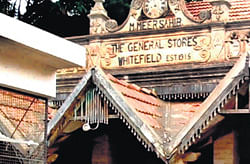An ongoing project called ‘Neighbourhood Diaries’ captures the tangible and intangible heritage of Bangalore’s localities such as Whitefield, Shivajinagar and Malleswaram in a series of films, writes Pushpa Achanta

History has many hues as it is often influenced by different beliefs and interpretations in spite of relevant audio-visual or textual records. But the content of these artefacts may also be debatable which actually makes the subject interesting. This is evident in ‘Neighbourhood Diaries’, an ongoing project that is capturing the tangible and intangible heritage of Bangalore localities like Whitefield, Blackpally (Shivaji Nagar) and Malleswaram in a series of short films.
‘Neighbourhood Diaries’ germinated in the Bangalore City Project initiated by Max Mueller Bhavan/Goethe Institut, Bangalore in 2010 in which Bangaloreans Archana Prasad (an artist, art historian and co-founder of ‘Jaaga’, a space for creative expression) and Krupa Rajangam, (a conservation architect and co-founder of architecture firm Saythu), collaborated. The women observed, “We realised the significance of neighbourhood histories and of involving people of a locality in uncovering and documenting the unique aspects of the places where they have been living or working. Further, we have portrayed the transformation of different neighbourhoods from colonial times to the present and shown the films to the corresponding communities and others.”
Whitefield stories
Situated on the periphery of Bangalore, Whitefield was named after David E S White, the President of the Eurasian and Anglo Indian Association of Mysore and Coorg in 1882, who contributed to its establishment. Formerly, a countryside ‘pensioners’ paradise’, it still has some villas and churches like the Memorial Church consecrated in 1886 on land donated by the then Maharaja of Mysore. ‘Circle without Circle’, the first of six shorts in the ‘Whitefield Diaries’ series demonstrates how personal preferences and prejudices dictate oral or intangible history. While some think that the locality owed its name to the presence of English and Anglo Indians, a few feel it is because of Bele Maidana (white ground) or a betta (hill) with white rocks.
In the next film, ‘The Past is a Foreign Country’, J E Giddens, an 83-year old Whitefield resident says, “There were only 35 families here until the 1930s. In the part called the Inner Circle, people were allotted plots at Re. 1 per head in 1888. But the old mud and stone bungalows have not lasted thanks to water seepage.” And in ‘Time Capsule’, another Whitefield veteran Vivian D’Souza talks about the long standing Waverly Inn owned by James Hamilton where Winston Churchill supposedly visited to pursue his interest in Hamilton’s daughter. According to D’Souza, nobody “coloured” could stay overnight in Whitefield until 1947.
“There were hardly any buses, water or gas but we had bullock carts, sheep and cycles. I miss the ragi fields next door. The crickets don’t seem to exist anymore,” said elderly resident Christa Moss whose husband Lionel was President of the Whitefield Settlers and Residents’ Association that has maintained the neighbourhood since 1905.
Blackpally and more
Contrastingly, ‘Blackpally Diaries’ is centred in Shivaji Nagar, a culturally diverse commercial hub near Bangalore Cantonment, supposedly named after the legendary Maratha warrior, Chatrapathi Shivaji. However, during the British era, it was called Blackpally.
“There are many stories behind why the area was referred to as Blackpally. Some people attribute it to the proliferation of natives while others say it is due to the existence of blacksmiths in the area. Another version considers it a distortion of the term “Bile akki pally” or “white rice town” based on a local variety of rice,” said Rajangam at a screening of ‘Trade Off’, the second in the Blackpally series.
Shot over two months mainly by French documentary film maker Clemence Barret, Trade Off was a personalised response to the fire that broke out in February 2012 in the iconic Russel Market housing nearly 480 shops spread across two acres on two floors.
Christened after a Britisher who planned the structure along with Sir Ismail Sait, it has existed for more than 80 years selling vegetables, fruits, flowers, fish, meat and dairy products.
The lady behind the lens remarked, “After the tragic incident, we wanted to highlight the ground realities of the traders. They include Parvez Ahmad, Secretary, Russel Market Traders’ Association, whose family has been here for four generations”.
‘Lost Sequel’, the other ‘chapter’ in the Blackpally Diaries, revolves round the history of Elgin Talkies, Bangalore’s oldest movie theatre that closed on December 29 last year after its ownership moved from the family of A S Krishnamurthy. “Veerabhadra Mudaliar, my great grandfather, opened it as Elgin Hall in 1896 to stage plays. It was christened after Lord Elgin, the then Viceroy of India. My grandfather brought a projector from Bombay and converted it to a cinema place in 1920. The roof of the edifice had hollow tiles to eliminate the echo”, the erstwhile owner mentioned on camera.
His brother A S Suryakumar added, “After the first Indian talkies was screened here in 1932, it became Elgin Talkies. There is a record of every movie shown here since then”.
As per the former proprietors, women had a separate ticket counter, entrance and seating enclosure. “We were urged to construct a narrative around this building as it is a popular landmark that was becoming history. Our hope is to shoot more in Blackpally before moving to Malleswaram as people are keen on preserving common heritage. But we need financial support to continue,” Rajangam revealed.
Deccan Herald is on WhatsApp Channels| Join now for Breaking News & Editor's Picks